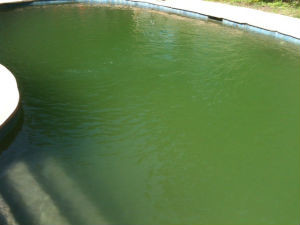While algae creates problems in swimming pools, they are one of the most important organisms on earth, capturing more of the sun’s energy through photosynthesis than all other plants combined.
Algae problems come because of extreme weather conditions and/or chemical imbalances in your pool. Excessive heat, wind and dust promote algae growth. If your water chemistry is off, then you are destined for an algae bloom. Algae grows best in indirect sunlight and in “dead zone” areas where circulation is poor. Rough or etched surfaces are ideal for algae growth, so it can “dig in” and firmly attach itself to the surface.
Green algae is most common, named for the chlorophyll molecule that carries out photosynthesis. They are the easiest to treat.
Mustard algae are similar to green algae, but have carotenoids, which gives them their color. Carotenoids are anti-oxidants which protect the algae against oxidation from chlorine, thus making mustard algae much harder to kill than green algae.
Black algae aren’t really algae—they are a bacteria that utilize photosynthesis. These bacteria form a sticky slimy covering to protect themselves from the surrounding environment. As the process of photosynthesis occurs, the carbon dioxide produced combines with calcium to create an additional protective barrier that can only be penetrated with rigorous brushing, thus exposing the bacteria to algaecide and oxidizer.
 So, what do you do if you have algae? First, shock your pool and manually brush the algae. The high concentration of chlorine will kill the outer layer of algae, exposing new algae to the shock. Taking a chlorine tab and rubbing it on the algae can also help. Rigorous frequent brushing is critical.
So, what do you do if you have algae? First, shock your pool and manually brush the algae. The high concentration of chlorine will kill the outer layer of algae, exposing new algae to the shock. Taking a chlorine tab and rubbing it on the algae can also help. Rigorous frequent brushing is critical.
Algaecides work by either removing oxygen from your water, essentially suffocating the algae, or by disrupting the metabolic or enzymatic activity within the algae cell. My preference is a silver algaecide.
Removing phosphate is an important part in controlling algae growth, as phosphates are algae’s main food source. Like humans who store energy as fat, algae also store phosphates so they can continue to grow, even though their food source has been removed. Thus it may take several treatments over time to completely eliminate the algae.
When you pour the phosphate remover into your pool, you’ll see an immediate reaction, as the water turns milky white. This is normal, as phosphates are binding to a chemical, making an aggregate large enough to get filtered out of your pool.
Once you’ve cleared your water, you still have algae spores in your filter, and in the right condition, you’ll get another bloom. So take the time to clean your filter after your water has cleared.
